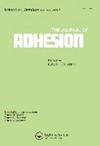在中等湿度的AFM上揭示了与材料相关的粘附力对压电速度的各种依赖性
IF 2.3
4区 材料科学
Q2 ENGINEERING, CHEMICAL
引用次数: 0
摘要
附着力的压电速度依赖性是矛盾的,需要在文献中加以澄清。在原子力显微镜(AFM)上,通过在潮湿条件下测量二氧化硅悬臂和具有不同材料的表面之间的相关性进行了研究。结果表明,速度依赖性与材料有关。根据这些表面,存在各种行为:(1)在临界速度以下的独立性和在临界速度以上的递减性;(2) 在低速时具有大的值并且在高速时具有独立性;(3) 在整个速度范围内的独立性;(4) 在低速时的独立性和在高速时具有大的值;(5) 呈指数级增长。高速下的下降归因于低粘度水桥中的拉脱不稳定性。高速下的大值归因于具有高粘度的动态粘性力。在整个速度范围内的独立性归因于牵引不稳定性和中等粘度的粘性力之间的折衷。指数增长归因于裂纹扩展过程。这些结果可以增加我们对附着力的了解,提出AFM参数的选择建议,并改进相关小型器件的设计。本文章由计算机程序翻译,如有差异,请以英文原文为准。
Material-related and various dependences of adhesion force on piezo velocity revealed on an AFM at moderate humidity
ABSTRACT Piezo velocity dependence of adhesion force is contradictory and requires clarification in the literature. The dependence was investigated with the measurements between a silica cantilever and surfaces with different materials in a humid condition on an atomic force microscope (AFM). The results demonstrate that the velocity dependence is correlated with materials. Depending on those surfaces, there are various behaviors: (1) independence below a critical velocity and decreasing above the critical velocity; (2) having large values at low velocities and independence at high velocities; (3) independence in the entire velocity range; (4) independence at low velocities and having large values at high velocities; (5) increasing exponentially. The decrease at high velocities was attributed to the pull-off instability in a water bridge with low viscosity. The large values at high velocities were attributed to the dynamic viscous force with high viscosity. Independence in the entire velocity range was attributed to the compromise between the pull-off instability and viscous force with moderate viscosity. The exponential increase was ascribed to a crack propagation process. The results may add to our knowledge of adhesion forces, propose selection recommendations of AFM parameters, and improve the design of relevant small-scale devices.
求助全文
通过发布文献求助,成功后即可免费获取论文全文。
去求助
来源期刊

Journal of Adhesion
工程技术-材料科学:综合
CiteScore
5.30
自引率
9.10%
发文量
55
审稿时长
1 months
期刊介绍:
The Journal of Adhesion is dedicated to perpetuating understanding of the phenomenon of adhesion and its practical applications. The art of adhesion is maturing into a science that requires a broad, coordinated interdisciplinary effort to help illuminate its complex nature and numerous manifestations.
 求助内容:
求助内容: 应助结果提醒方式:
应助结果提醒方式:


